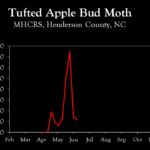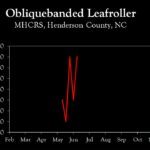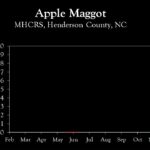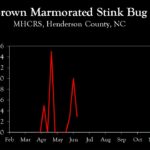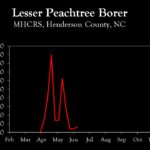WNC Orchard Insect Pest Populations – June 12, 2023
go.ncsu.edu/readext?941150
en Español / em Português
El inglés es el idioma de control de esta página. En la medida en que haya algún conflicto entre la traducción al inglés y la traducción, el inglés prevalece.
Al hacer clic en el enlace de traducción se activa un servicio de traducción gratuito para convertir la página al español. Al igual que con cualquier traducción por Internet, la conversión no es sensible al contexto y puede que no traduzca el texto en su significado original. NC State Extension no garantiza la exactitud del texto traducido. Por favor, tenga en cuenta que algunas aplicaciones y/o servicios pueden no funcionar como se espera cuando se traducen.
Português
Inglês é o idioma de controle desta página. Na medida que haja algum conflito entre o texto original em Inglês e a tradução, o Inglês prevalece.
Ao clicar no link de tradução, um serviço gratuito de tradução será ativado para converter a página para o Português. Como em qualquer tradução pela internet, a conversão não é sensivel ao contexto e pode não ocorrer a tradução para o significado orginal. O serviço de Extensão da Carolina do Norte (NC State Extension) não garante a exatidão do texto traduzido. Por favor, observe que algumas funções ou serviços podem não funcionar como esperado após a tradução.
English
English is the controlling language of this page. To the extent there is any conflict between the English text and the translation, English controls.
Clicking on the translation link activates a free translation service to convert the page to Spanish. As with any Internet translation, the conversion is not context-sensitive and may not translate the text to its original meaning. NC State Extension does not guarantee the accuracy of the translated text. Please note that some applications and/or services may not function as expected when translated.
Collapse ▲ At this time, the major pest of concern is first generation tufted apple bud moth (TABM) in Henderson County and at similar elevations. Across the region, green apple aphid and potato leafhopper are also appearing. There has also been at least one report of woolly apple aphid.
At this time, the major pest of concern is first generation tufted apple bud moth (TABM) in Henderson County and at similar elevations. Across the region, green apple aphid and potato leafhopper are also appearing. There has also been at least one report of woolly apple aphid.
TABM degree day accumulation since biofix is at about 830 DD in Henderson County, which is equivalent to 8% egg hatch of the first generation, and represents the beginning of the window for optimum control. Excellent control is achieved with a single insecticide application made between 800 and 1200 DD, so anytime between now and the next two weeks will be sufficient. Recommended insecticides include Intrepid, Delegate or a diamide (Altacor, Exirel or Verdepryn). Intrepid is an inexpensive and excellent option under conditions of low codling moth pressure, while Delegate or a diamide should be considered if codling moth is still a concern. If one of the diamides has been used previously for codling moth, continue to use one of those products. Conversely, if Delegate has been used for first generation codling moth then continue to use that material.
The window for TABM control in lower elevations opened earlier, about 10 to 14 days ago. Hence, if one of the above insecticides was applied in the past two weeks, that should be sufficient TABM control.
First generation codling moth egg hatch is complete in Cleveland County and similar elevations with more than 1000 DD accumulated since biofix. In higher elevations (i.e., Henderson County), 730 DD have accumulated, which is equivalent to about 60% egg hatch. However, the threat of damage is minimal in orchards that have not experienced problems up to this point in time. Also, we are in the midst of second generation OFM flight, but as mentioned in previous posts, second generation OFM is rarely a problem.
Regarding green apple aphid and potato leafhopper, there are many materials available for control of these pests, including Actara, Admire (and generics), Assail, Belay, Sivanto Prime, Closer and Versys. For all materials, the lower end rates are recommended for aphids and leafhoppers. Both pests infest new shoot growth and are of greatest concern on high-density plantings or newer plantings compared to older trees. In addition to aphids and leafhoppers, expect Japanese beetle to begin emerging in lower elevations at any time.
Learn more about southeastern apple insect pests at the Apple Insect Management page.
2023 Average Weekly Trap Captures
| HENDERSON COUNTY | |||
| Insects per trap | |||
| May 30 | June 5 | June 12 | |
| Codling moth | 1.0 | 0.5 | 0.0 |
| Oriental fruit moth | 6.0 | 10.5 | 13.5 |
| Tufted apple bud moth | 75.0 | 14.0 | 12.0 |
| Redbanded leafroller | 0.0 | 10.0 | 8.0 |
| Obliquebanded leafroller | 7.0 | 3.0 | 7.0 |
| Lesser appleworm | 4.0 | 2.0 | 4.0 |
| Apple maggot (abandoned and research orchards) | 0.0 | 0.0 | 0.0 |
| Brown marmorated stink bug (commercial) | – | – | – |
| Brown marmorated stink bug (unsprayed) | 1.0 | 1.0 | 0.3 |
| Spotted tentiform leafminer | 0.0 | 0.0 | 0.0 |
| Dogwood borer | 37.0 | 36.0 | 18.0 |
| Peachtree borer | 0.0 | 8.0 | 0.0 |
| Lesser peachtree borer | 2.0 | 2.0 | 3.0 |
| San Jose scale | 0.0 | 0.0 | 0.0 |
*Note that these averages illustrate only the timing of insect emergence and fluctuations in populations, and are not representative of population levels in any given orchard. The only way to have an accurate assessment of an individual orchard’s populations is to set up traps in that orchard.
2023 Accumulated Degree Days
| HENDERSON COUNTY | ||||
| May 30 | June 6 | June 12 | ||
| Codling moth (Biofix: April 7) | 525 | 623 | 716 | |
| Oriental fruit moth (Biofix: March 24) | 922 | 1050 | 1176 | |
| Tufted apple bud moth (Biofix: April 21) | 569 | 697 | 823 | |





